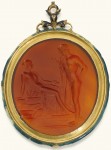 I sometimes daydream about what it would be like to be the Getty with its wondrously Midas-like resources. Imagine going to an auction looking to buy an object estimated to sell for $10,000-15,000 and being able to walk out with it even though the final hammer price with buyer’s premium is $508,765. The J. Paul Getty Museum did just that with an exquisite 1st century A.D. Roman intaglio gemstone sold earlier this month at Sotheby’s London.
I sometimes daydream about what it would be like to be the Getty with its wondrously Midas-like resources. Imagine going to an auction looking to buy an object estimated to sell for $10,000-15,000 and being able to walk out with it even though the final hammer price with buyer’s premium is $508,765. The J. Paul Getty Museum did just that with an exquisite 1st century A.D. Roman intaglio gemstone sold earlier this month at Sotheby’s London.
The gem—made of sard, a reddish-brown translucent quartz—is exquisitely engraved. The identity of the artist is uncertain, although the scholar Marie-Louis Vollenweider has suggested it is the work of Aulos, one of the finest engravers working in the circle of the imperial court of Emperor Augustus in the late first century B.C., who signed several other gems of related style. The beautiful gilt mount dates from the eighteenth century.
“The gem’s superb quality, impressive size, and excellent condition will enhance our holdings of engraved gems, one of the strengths of the Museum’s antiquities collection,” said Timothy Potts, director of the Getty Museum. “It will go on view in the Villa’s reinstalled galleries alongside other engraved gems, including our amethyst Apollo attributed to the engraver Solon and the engraved gem of the head of Demosthenes signed by Apelles.”
The figures have been identified as pretty much every couple in Greco-Roman mythology at various times — Paris and Oenone, Phaon and Sappho, a muse and comic poet. The Getty is leaning towards Aphrodite and her handsome lover Adonis. Sotheby’s stayed on the safe side describing it simply as a “Standing youth conversing with a seated maiden.”
This piece has an illustrious and adventurous history, which at least in part explains the crazy price. Its first documented owner was Pierre-Jean Mariette, an 18th century Parisian art dealer who wrote the first modern sale catalogue. From Mariette it passed into the fabled collection of cameos and intaglios assembled by Charles Spencer, 3rd Duke of Marlborough, and his son, also named Charles, who enlarged the collection. One of the George Spencers, it’s not known which one, bought this particular intaglio. The collection of engraved gems and cameos was so important that the 4th Duke of Marlborough gave them pride of place in a monumental family portrait by Joshua Reynolds on display in the Red Drawing Room of Blenheim Palace. The Duke holds a large cameo in his hand, while his son, standing to his left, carries a red morocco leather case under his arm, one of ten such cases that held the gem collection.
 The Marlborough Gems remained in the Spencer-Churchill family until 1875 when money troubles compelled the 7th Duke to sell the entire collection, more than 800 pieces, to wealthy colliery owner David Bromilow. After his death, Bromilow’s daughter Julia Harriet Mary Jary sold the collection piecemeal at a Christie’s auction in 1899. The great collection was dispersed so widely that scholars are still trying to track down more than 500 of the pieces.
The Marlborough Gems remained in the Spencer-Churchill family until 1875 when money troubles compelled the 7th Duke to sell the entire collection, more than 800 pieces, to wealthy colliery owner David Bromilow. After his death, Bromilow’s daughter Julia Harriet Mary Jary sold the collection piecemeal at a Christie’s auction in 1899. The great collection was dispersed so widely that scholars are still trying to track down more than 500 of the pieces.
This one could so easily have disappeared too, but its ownership history is remarkably well preserved. It was acquired by Frankfurt industrialist and art collector Friedrich von Gans. He died in 1920 and by that time the intaglio was in The Hague in the newly established art gallery of Kurt Walter Bachstitz, a Jewish German-Austrian dealer. Bachstitz’s business was very successful, with offices in New York and Berlin. He and his wife moved from Germany to The Hague in 1938 fleeing Nazi persecution.
It wasn’t a long reprieve. Come the Nazi occupation of the Netherlands, Bachstitz was quickly targeted by Hans Posse, director of the Sondernauftrag Linz, the organization in charge of stealing/coercing art and antiquities for Hitler’s Barbie Dreamhouse museum in Linz. Posse bought the intaglio in 1941 for far less than its market value. It was stashed in the salt mines of Altaussee, Austria, along with thousands of other priceless pieces including Jan van Eyck’s Ghent Altarpiece. The intaglio was found there by the Monuments Men who, in accordance with Allied policy, returned it to the Netherlands Art Property Collection even though it was privately owned when the Nazis snatched it.
Kurt Walter Bachsitz petitioned the Dutch government for restitution of his property, but except for one painting Jan Steen, the government kept everything. Their position was that Bachsitz was well-connected (his Protestant wife’s brother was Hermann Göring’s art buyer) and was not subject to Nazi coercion in 1940-1, so all the stuff Posse bought at bargain-basement prices was just normal business. Bachsitz’s heirs are still fighting to find and reclaim his lost artworks today. The intaglio was restituted to his heirs this year and they put it on the auction block. The hammer price must have been a pleasant surprise for them.
Sold by the Marlborough’s to pay for Jenny Churchill’s ludicrous extravagances?
Something supposed to be 2000 years old is in excellent condition?
Something smells.
Friends on mine have pointed out some, err, anomolies with this.
1. Far from having “a long and distinguished provenance” there is no provenance at all 0 AD to 1600 AD.
2. If Aulos signed several other gems of related style, why not this one?
3. The eighteenth century mounting looks like it has much more wear & tear than that 2,000 year old engraving.
There are more anomolies, but that’s enough to give you the idea.
The Getty press release mentions the gem’s “impressive size,” but doesn’t say what that is. Are we talking two inches or ten?
That Reynolds painting of the Duke’s family is wonderful! The five daughters and the dogs are what really make it. The parents and the son seem listless by comparison.
Oops. Maybe one of the five daughters is actually a second son…
‘Hitler’s Barbie Dreamhouse’ !!! :hattip:
No doubt intended to cause a furor in those days…
I do wish that the Getty didn’t sit in the Ring of Fire. Still, if Mt St Helens blows I don’t suppose it would much matter where in North America the Getty is.